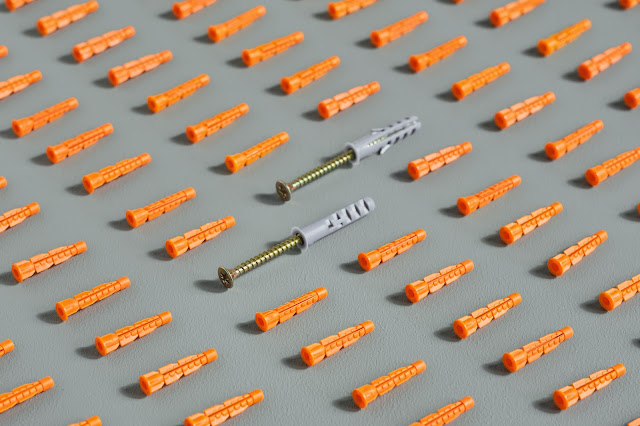Ultimate Guide to Frame Anchors Plug & Screw: Ensuring Stability for Your Wall Hangings
Hanging pictures, mirrors, or shelves on your walls can be a daunting task. How do you ensure that your wall hangings are stable and secure, without causing any damage to your walls? The answer lies in using the right type of frame anchors, specifically plug and screw anchors. In this ultimate guide, we will provide you with all the information you need to choose and install the perfect frame anchors for your wall hangings, ensuring their stability and safety.
Understanding Frame Anchors: What are They and Why are They Important?
Frame anchors are specialized hardware used to secure wall hangings, such as picture frames, mirrors, and shelves, to walls. They provide stability and support by distributing the weight of the hanging object evenly across the wall surface. This is particularly important for heavy or large wall hangings, which can cause damage to the wall or even fall if not properly secured.
Using the right type of frame anchor is essential for maintaining the integrity of your walls and ensuring the safety of your wall hangings. There are several types of frame anchors available, each designed for specific wall materials and hanging weights. In this guide, we will focus on plug and screw anchors, which are versatile and suitable for a wide range of wall materials and hanging weights.
Types of Frame Anchors: Choosing the Right Anchor for Your Wall
There are several types of frame anchors available, each with its own advantages and disadvantages. Some of the most common types include:
- Wall anchors: These are general-purpose anchors that can be used with a variety of wall materials, including drywall, plaster, and masonry. Wall anchors come in several styles, such as plastic expansion anchors and toggle bolts.
- Drywall anchors: As the name suggests, these anchors are specifically designed for use with drywall. They come in various styles, including threaded anchors and toggle anchors.
- Plaster anchors: These anchors are similar to drywall anchors but are designed for use with plaster walls. They typically have a longer screw to accommodate the thicker plaster material.
- Heavy-duty anchors: These anchors are designed for use with heavy or large wall hangings and can support significant weight. They are typically made of metal and come in various styles, such as sleeve anchors and wedge anchors.
- Plug and screw anchors: These versatile anchors can be used with a variety of wall materials and are suitable for a wide range of hanging weights. They consist of a plastic or metal plug that is inserted into a pre-drilled hole in the wall, followed by a screw that is driven into the plug to secure the hanging.
Plug and Screw Anchors: A Closer Look
Plug and screw anchors are a popular choice for securing wall hangings due to their versatility and ease of installation. They can be used with various wall materials, including drywall, plaster, and masonry, and can support a wide range of hanging weights.
The plug component of the anchor is typically made of plastic or metal and is designed to expand as the screw is driven into it. This expansion creates a tight, secure fit within the wall, ensuring that the hanging is stable and supported.
When selecting plug and screw anchors, it's important to choose the right size and type for your specific wall material and hanging weight. Be sure to follow the manufacturer's recommendations for the appropriate anchor size and weight capacity.
Installing Plug and Screw Anchors: A Step-by-Step Guide
Installing plug and screw anchors is a relatively simple process that can be completed with a few basic tools. Follow these steps to ensure a secure and stable installation:
1. Determine the appropriate anchor size and type for your wall material and hanging weight. Consult the manufacturer's recommendations if you're unsure.
2. Mark the desired location for the anchor on the wall, using a pencil or other marking tool.
3. Using a drill and the appropriate size drill bit, create a hole in the wall at the marked location. Be sure to drill to the recommended depth for the anchor.
4. Insert the plug component of the anchor into the hole, ensuring that it is flush with the wall surface
5. Drive the screw into the plug, using a screwdriver or drill with a screwdriver bit. As the screw is driven into the plug, the plug will expand, creating a secure fit within the wall.
6. Attach your wall hanging to the screw, following the hanging's specific installation instructions.
5. Tips for Ensuring Stability and Safety of Your Wall Hangings
To ensure the stability and safety of your wall hangings, keep the following tips in mind:
- Always choose the appropriate anchor size and type for your wall material and hanging weight. Consult the manufacturer's recommendations if you're unsure.
- Use a level to ensure that your wall hanging is straight and level before securing it to the wall.
- Regularly inspect your wall hangings and anchors for signs of wear or damage. Replace any damaged anchors immediately to prevent potential accidents.
- Be cautious when hanging heavy or large items, particularly in high-traffic areas. Consider seeking professional assistance for particularly heavy or complex installations.
Frequently Asked Questions About Frame Anchors
Q: Can I use plug and screw anchors in hollow walls?
A: While plug and screw anchors can be used in a variety of wall materials, they may not provide adequate support in hollow walls. In these cases, consider using a specialized hollow-wall anchor, such as a toggle bolt.
Q: How do I remove a plug and screw anchor from the wall?
A: To remove a plug and screw anchor, simply unscrew the screw from the plug and gently pull the plug out of the wall. If the plug is difficult to remove, you may need to use pliers or a similar tool to help extract it.
Q: Can I reuse plug and screw anchors?
A: While it's possible to reuse plug and screw anchors, it's not recommended, as the anchor may not provide the same level of support and stability upon reinstallation. It's best to use a new anchor for each installation.
Conclusion: The Importance of Proper Frame Anchor Installation
In conclusion, using the right type of frame anchor, such as plug and screw anchors, is essential for ensuring the stability and safety of your wall hangings. By following the proper installation steps and regularly inspecting your anchors and wall hangings, you can prevent potential accidents and damage to your walls. Always choose the appropriate anchor size and type for your specific wall material and hanging weight and consider seeking professional assistance for particularly heavy or complex installations.




